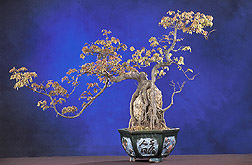This page has been archived and is being provided for reference purposes only. The page is no longer being updated, and therefore, links on the page may be invalid.
|
Read the magazine story to find out more. |
National Bonsai and Penjing Museum--a Sight to BeholdBy Alfredo FloresJune 11, 2003 The National Bonsai and Penjing Museum, part of the U.S. National Arboretum in Washington, D.C., allows the general public to enjoy and learn about these interesting, living art forms free of charge. The arboretum is operated by the Agricultural Research Service, the U.S. Department of Agriculture's chief scientific research agency. Masters of Japanese bonsai and Chinese penjing techniques are gardening artists, meticulously shaping miniaturized trees--ranging in age from newborn to centenarian--to create a sense of full-grown trees in their natural surroundings. They do this while only taking up the space of a small coffee table. The art form has also spawned many North American bonsai artists, who have made major additions to the museum's collection. The museum opened in 1976, when the Nippon (Japan) Bonsai Association donated 53 bonsai to the people of the United States to commemorate the American bicentennial. Now, more than 200,000 people annually visit the museum's collection of 150 plants located in three recently renovated pavilion houses. A penjing worth noting in the museum's collection is the "Trident Maple," an example of the "root-over-rock" style. It has been molded in the shape of a dragon, with one of its larger branches looking like the head and another, the tail. The technique for growing artistically shaped, miniature trees in pots originated in China, where it was known as penjing, and subsequently spread to Japan, where it was modified and known as bonsai. The museum's oldest tree is a 400-year-old Japanese white pine. This bonsai survived in a nursery about two miles from where the atom bomb was dropped on Hiroshima, Japan, in 1945. The most photographed bonsai in the museum's impressive collection is "Goshin," meaning "Protector of the Spirit," which is currently displayed prominently at the entrance of the museum's refurbished courtyard. Read more about this national museum in the June issue of Agricultural Research magazine. |

